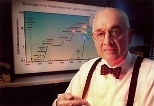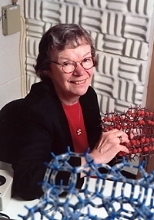Nick Holonyak, inventor of the LED (light-emitting diode), and Edith Flanigen, whose pioneering work in chemistry and materials science helped make petroleum refinement cleaner and safer, have both won Lemelson-MIT prizes.
Holonyak received the $500,000 Lemelson-MIT Prize for Invention--the world's largest single cash prize for invention--at a ceremony on Friday, April 23 in Washington, D.C. At the same ceremony, Flanigen received the $100,000 Lemelson-MIT Lifetime Achievement Award, which recognizes her cumulative contributions to technological progress and invention.
Light from a chip
Holonyak invented the first practical LED in 1962. Today, LEDs illuminate everything from alarm clocks to the NASDAQ billboard in New York's Times Square. LEDs produce more lumens per watt than both incandescent and halogen lights, making them more environmentally friendly and cost-effective. And their long lifespan makes them ideal for use in automotive dashboards and taillights, traffic signals and consumer electronics displays.
Holonyak, now the John Bardeen Professor of Electrical and Computer Engineering and Physics at the University of Illinois. was the first student of John Bardeen, one of the inventors of the transistor in the early 1950s. After finishing graduate school in 1954, Holonyak took a job with Bell Labs and was part of a team whose work led to the invention of the integrated circuit. Later, at General Electric, Holonyak invented the shorted emitter p-n-p-n switch, now widely used in household dimmer switches and power tools.
"I learned pretty early in life that you don't have to learn everything to be able to do something. With inventing, you are attempting to solve a problem within your reach, not trying to resolve the world's greatest problems," said the 75-year-old Holonyak.
Creating new materials
"Many people may not know about Edith Flanigen's discoveries, but her inventiveness and creativity have greatly affected everyone's life," said Professor Merton Flemings, director of the Lemelson-MIT Program. "Her discoveries have resulted in more than 100 patents and have revolutionized the world of molecular sieve materials."
Flanigen's pioneering work in chemistry and materials science over the past four decades has helped make the petroleum refinement process more efficient, cleaner and safer.
Flanigen began her career in 1952 as a research chemist at Union Carbide in Tonawanda, N.Y. She and her two sisters all worked at Union Carbide at a time when few women were making strides in the sciences. She eventually became the first woman to hold the company's highest technical position, senior research fellow.
Her most important work led to the development of a new generation of molecular sieves, which are porous crystals that can separate molecules on the basis of size. Flanigen and co-workers discovered a large number of novel structures and compositions of molecular sieves, which enabled their use in a wider range of applications. Molecular sieves are now used in everything from converting crude oil into gasoline, to cleaning up nuclear waste.
Flanigen also co-invented a material called silicalite, which is widely used in environmental cleanup applications to selectively adsorb organic compounds. Additionally, she developed a synthetic emerald that was designed for use in masers--a predecessor to the laser that was based on microwaves instead of light.
Flanigen, who is now 75, retired in 1994 and now consults to UOP.
Invention Assembly
On April 21, the Lemelson-MIT Program presented a conference called an Invention Assembly held at the National Academy of Engineering. Participants discussed a new report titled "Invention: Enhancing Inventiveness for Quality of Life, Competitiveness and Sustainability" that was prepared by the Lemelson-MIT Program with funding from the National Science Foundation.
Authored by some of the nation's leading experts on invention, the report asserts that important sectors--including government, business and education--must actively foster inventiveness to safeguard the United State's innovative edge in an increasingly competitive global market.
The Invention Assembly was a day-long conference featuring academics, decision-makers and business people who have examined the topic of invention from the perspectives of history, cognitive science, education, intellectual property law and sustainable development.
A version of this article appeared in MIT Tech Talk on April 28, 2004.







